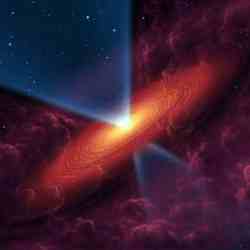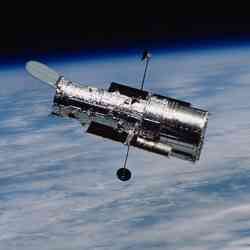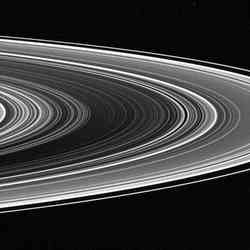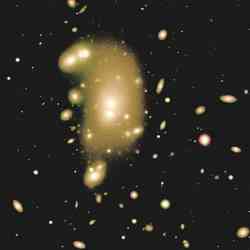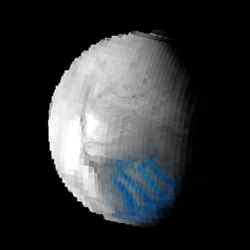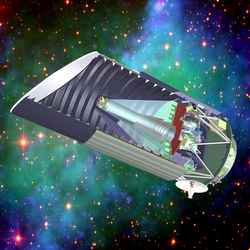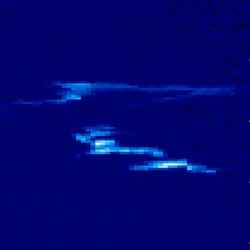
Listen to the interview: Interview with Simon Singh (8 MB)
Or subscribe to the Podcast: universetoday.com/audio.xml
Fraser: I just finished reading Big Bang and I really enjoyed it. How did you choose it as a subject for your next book after the Code Book?
Simon Singh: I think I was in an airport lounge one day and started chatting with somebody about what do you do, and I started telling him that I was a science writer, or science communicator. We got to the subject of cosmology, and something struck me. This person was fairly intelligent and very curious about the world and yet they knew nothing about the Big Bang theory. In fact, they seemed to think that the whole thing was a fairy tale. So I started telling them about the Big Bang theory and the fact that it wasn’t just a fairy tail. There’s hard evidence to back it up. And I said hey, if this person doesn’t know about the Big Bang theory, maybe there are lots of other people who don’t know what the Big Bang theory is. That struck me as a huge shame because for years we’ve wondered where the Universe came from. We looked up into the sky and we wondered what was the origin of everything in being. Now we have a theory, and I just think it would be a great shame if more people didn’t know what that theory is. So that was kind of the motivation for writing the book.
Fraser: And in doing your research for the book, did you find you gained a deeper appreciation of the theory?
Singh: Oh yes. My background is not in cosmology; my background is as a particle physicist. So I tend to write about things that are familiar and known to me. I’m not a mathematician, so when I wrote Fermat’s Enigma I started from scratch and developed a whole new appreciation of number theory and pure mathematics. I’m not a cryptographer, so when I wrote The Code Book from scratch again, I learned about the history of cryptography and why privacy and security are so important; not just historically, but also today. As someone who really knew very little about astronomy and cosmology, it was a challenge but really rewarding to have to spend 2-3 years exploring the world of astronomy/cosmology and getting to grips with it myself.
On the one hand, that makes it tough, because I’ve got a huge amount of work to do. But on the positive side, I get a lot out of it. Maybe because I’m learning things for the first time, it helps me try to convey some of those difficult ideas to a more general audience. I look at people like Brian Greene. On the one hand, he’s got a huge advantage of having a great understanding of his subjects – he’s among the world’s experts on string theory. That must help him when he writes his book, but on the other hand, it’s all so familiar to him. He has to overcome the hurdle of not being blase about it; of not taking things for granted. It’s an advantage and disadvantage. There are clearly writers who are researchers in the field and writers who are more generalists. I’m certainly a generalist, with a background in particle physics, not astronomy.
Fraser: When I read Big Bang, you could really see the different pieces – the trains of evidence – all come together, and each one is quite amazing how a theorist made a prediction about perhaps what the nature of the Universe was going to be, and then the observers, in many cases found those observations to be true. The Big Bang is obviously still just a theory, like much else in science, but at the same time it almost holds a special place in scientific thinking.
Singh: In a way, what the book is really about is: what is science? Fermat’s Enigma is really a book about: what is mathematics? The Code Book is more generally about: what’s technology? And the Big Bang is partly about… it’s entirely about the Big Bang theory, but at a deeper level, it’s about: what is science? How does science work? How do we know a theory is true? How is a theory developed? How is it tested? How do they turn themselves from being maverick theories into mainstream theories? That’s really what I wanted to explain. The concept of paradigm shifts in science, when you have one idea – that maybe the world is flat – and then we all come to realize that the world is round. How does the community of science transform itself from having one belief to having another belief?
So that’s really what the book’s about. This maverick idea of the Big Bang comes along. Everybody else believes the Universe has been around forever; certainly in the science community. And over the course of half a century, there’s this paradigm shift to a Universe that hasn’t been here forever. One was created a finite time ago, in a very different state from the Universe we have today.
You use the expression “just a theory”, and what I try to explain in the book is that everything is “just a theory”. But the question is, how much evidence do you have to back up your theory? String theory is just a theory. It’s very speculative, it doesn’t have any evidence to back it up. The Big Bang is “just a theory”, but there’s a huge amount of evidence to back it up. The fact that we see the galaxies flying away from us shows us that the Universe is expanding; that it presumably started in a hot, dense compact state and then expanded outwards. The fact that we see the abundance of hydrogen and then helium in the Universe. That relative abundance can be explained by the fact that the Universe started out hot, dense, compact, and in that state there were nuclear reactions that turned hydrogen into helium, giving us the exact ratio that we have today. If there was a Big Bang, there should have been an afterglow of the Big Bang; a radiation following the moment of creation – the cosmic microwave background radiation. Sure enough we see that radiation in exactly the right wavelength you’d expect if there was a Big Bang. So, it is just a theory with a huge amount of evidence. So, that’s what I’m trying to do in the book.
On the other hand, although I believe that the evidence in favour of the Big Bang is now overwhelming, and it’s just accepted in the way that we accept that the continents drift around, or the same way that we believe that life developed through theory of natural selection and evolution. But there are gaps in that theory. It’s incomplete. Similarly, the Big Bang theory is incomplete. It’s not perfect. But on the other hand, it’s clearly fundamentally and basically correct. And that’s really what I wanted to stress in the book.
Fraser: In reading the book, I got to the end and I was actually surprised at how quickly it wrapped up. You wrapped up with the cosmic microwave background radiation, and I was kind of hoping to hear about some of the later advances about dark matter and dark energy. You really just added a few sentences at the end of the book. Why did you leave those out?
Singh: When I look around the book stores, I see lots of books that talk about dark matter and dark energy and string theory and inflation. So in a way, my book is deliberately different because it focuses on what we do know rather than what we don’t know. So while most people are working at the frontiers of cosmology, on the very latest speculative research, I’ve said, let’s look back at what we do know; let’s look at the core of the Big Bang model. Let’s understand who came up with that idea. How’s it put forward, and pioneered, how’s it tested, how do observations conflict, how did scientists resolve that conflict. As I was saying earlier, this is a book about how science works. And so I wanted to take as a scientific theory that was well developed, and tested, rather than a part of that theory that was still being challenged, or still under debate. So the core of the book is about the history of the Big Bang and why we believe it’s true. It’s fairly standard science. But on the other hand it hadn’t really been covered in sufficient detail for the lay reader. And then I came to the end of the book and I said, hang on, I can’t just ignore that there are gaps in the Big Bang theory, that there are gaps in cosmology, so I have an epilogue where I touch on the issues of inflation and dark matter and dark energy and so on. And then it becomes a really difficult issue because a writer wants you to get to a certain point. The reader just wants to know more and more, and there are more questions that need to be answered and suddenly you run into writing dozens and dozens of pages. So, I deliberately kept it brief at the end, and pointed people towards many of those other books that cover those other frontiers of cosmology that people are working on today.
Fraser: Right, I can imagine how just explaining any one of those topics would have kept you busy for a similarly sized book. Are there any pieces left with the Big Bang that people are working on now that maybe will fill in some outstanding pillars in the theory right now. What would you say is the big one that they’re working on right now?
Singh: For example, when I was an undergraduate, say about 20 years ago and I was doing my cosmology and astronomy courses, the question was: how does the Universe end? The assumption was that gravity would pull the Universe back, gravity would pull the galaxies back towards each other and certainly slow down the expansion of the Universe; maybe stop the expansion and maybe even cause the Universe to collapse in a Big Crunch. That was kind of the standard view. Gravity slows down the expansion, and then about a decade ago, a few observers started to try and measure that slowing down of the expansion by looking at supernovae. And the strange thing was that the Universe is not slowing down, it’s actually accelerating. It’s getting faster and faster and faster. There original measurements were made back around 1997. They were queried, they were made available, there were checked, they were double-checked, they were independently verified, and now it really does seem like we’re in a kind of runaway universe. And if the Universe is accelerating, as well as gravity, there must be some kind of anti gravity, some kind of long range anti gravity force that’s driving this expansion and that’s generally known as “dark energy”. So that’s probably one of the greatest discoveries that have shaken the Big Bang theory, but I don’t think it contradicts the Big Bang theory, I don’t think it even undermines it, but it certainly highlights a lack of understanding in one part of it. So that’s certainly an issue of great concern at the moment.
I remember some time ago I was traveling across North America and I was watching the Dave Letterman show and he was talking about a newspaper story in the New York Times. He opened the New York Times and he turned the pages and he eventually got to page 13 and he started telling the audience about this story that the Universe is accelerating. I think the headline was “Universe is going to rip itself apart”. And he said, well, that’s interesting for two reasons: first of all, the Universe is going to rip itself apart, and secondly, this is only on page 13. If this is really the case, it should be on the front page. So that’s certainly one of the areas that cosmologists chat about over their coffee in the morning.
Fraser: So I’ve got to know, what are you working on next?
Singh: I’m really not sure. I think this year I’ll spend a lot of time traveling, giving talks in Canada and America. I’ve just come back from Australia/New Zealand, Greece and Germany. And this year I’ll be going to Sweden and India and so on. It takes up a huge amount of time, once the book’s been published. I’ve just finished a theatre project, where we’re giving science lectures in a West End theatre in London, which has been a great success. But we’d originally did 9 shows with my colleague and myself Richard Wiseman, who’s a psychologist. It covers biology, psychology, physics, chemistry, astronomy and it’s been such a success we’ve extended the run. We’ve sold out new shows, we’ve sold out more shows, and that’s been great fun. But also, a lot of our time’s just been spent doing stuff I should have been doing for the last two or three years, but have just been too busy writing the book. Once I’ve cleared out my backlog, once we’ve finished the theatre of science, once I’ve finished giving talks around the world this year, next year I’ll start to focus on something new. But as of yet, I’m really not sure what that’ll be.
You can learn more about Simon Singh from his website at simonsingh.com
You can also read my review of Simon’s latest book, Big Bang.
